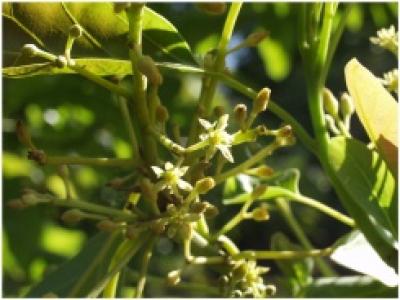Cultural Management Library
One of the most important avocado grove cultural management practices is walking your grove and taking notes on the health, growth cycles and management principles you’ve applied for your trees. Notes such as this can also help you determine whether or not your avocado groves are in an alternate bearing cycle.
Image

Having a good idea how many flower buds are developing and the progress of flower bud growth are useful pieces of information for growers in their decision making. By determining if flowering will be stronger than expected a grower can alter harvest timing decisions.
Alternate bearing is a two-year on-crop/off-crop cycle that results in high-quantity harvests in one year, followed by small-quantity harvests in the next year.
Image

Unlike deciduous fruit trees, avocado trees never go dormant, thus avocado trees have three concurrent growth cycles. They are developing the current year’s fruit and providing nutrients and resources that mature the fruit for harvest. They are supporting the needs of the year two fruit set that will be harvested the following year.
It’s important to walk your avocado groves, make observations and record the specific details about the state of your avocado trees year-round. This allows you to track changes over time and review your cultural management decisions. What should you look for and record in spring?
In California avocado groves, cool temperatures before and during the main period of bloom can have an adverse effect on avocado production. Cold temperatures also affect tree pollination.
Healthy green avocado leaves are critical for getting the best yields from avocado trees, and at flowering, because the leaves convert sunlight into sugars that support the production of fruit on the trees.
Unlike deciduous fruit trees that have defined seasons and go dormant annually — avocado trees are subtropical/tropical fruit trees that never go dormant. They are always growing and developing — even in winter. It takes two years to develop an avocado fruit from bud break of a vegetative shoot to harvest.
Alternate bearing cycles result in on-crop harvests (large amount of fruit) followed by off-crop harvests (minimal amount of fruit). These alternate bearing cycles can be caused by a variety of factors.
Ideally, an avocado tree would produce a similar crop each year. But avocado trees tend to adopt an alternate bearing cycle — an on-crop year (a large crop of fruit that is usually smaller in size) followed by an off-crop (less fruit that is generally larger in size) year. Once started, an alternate bearing cycle can be self-perpetuating.
Pagination
- First page
- Previous page
- …
- 8
- 9
- 10
- 11
- …
- Next page
- Last page